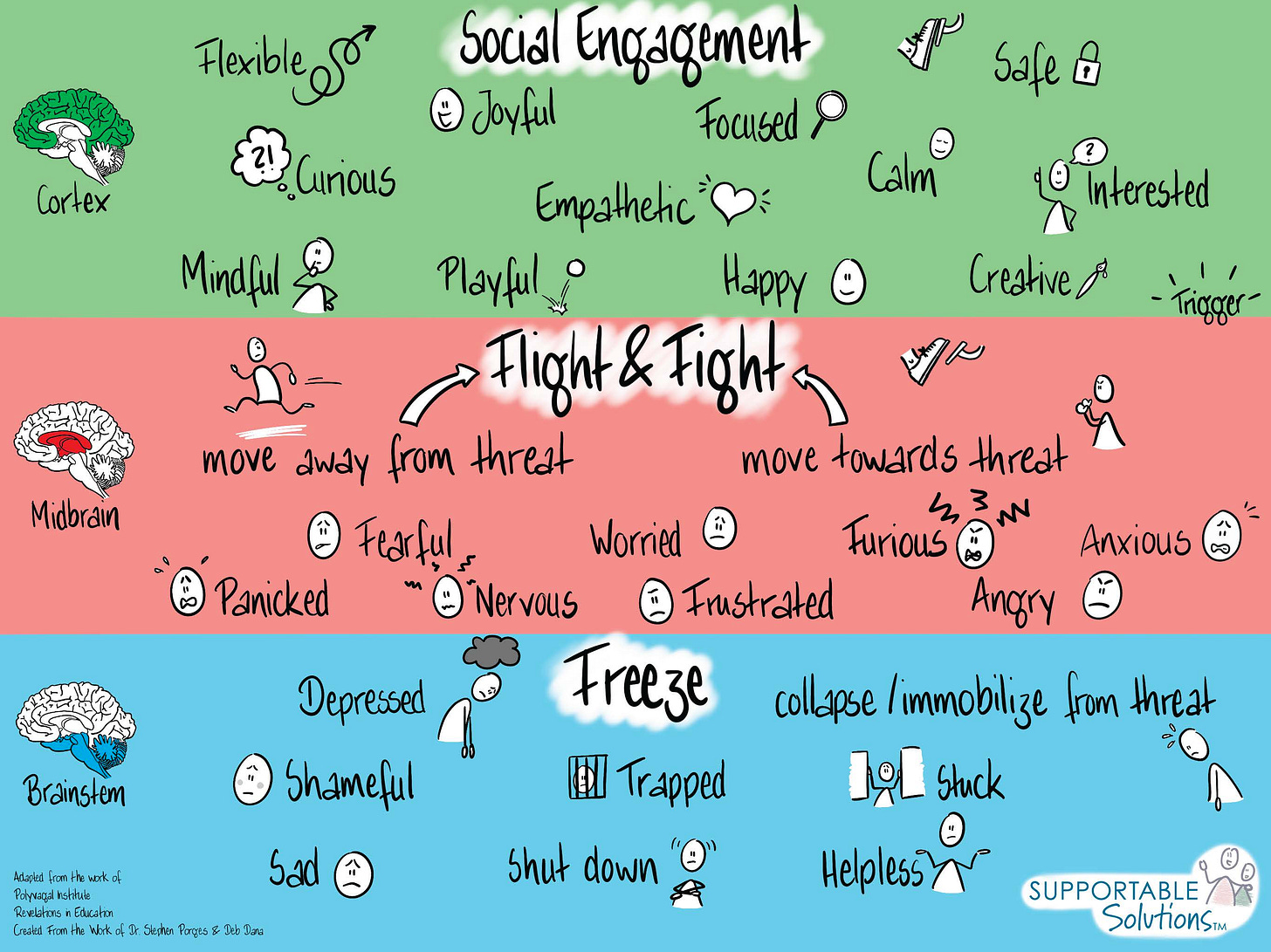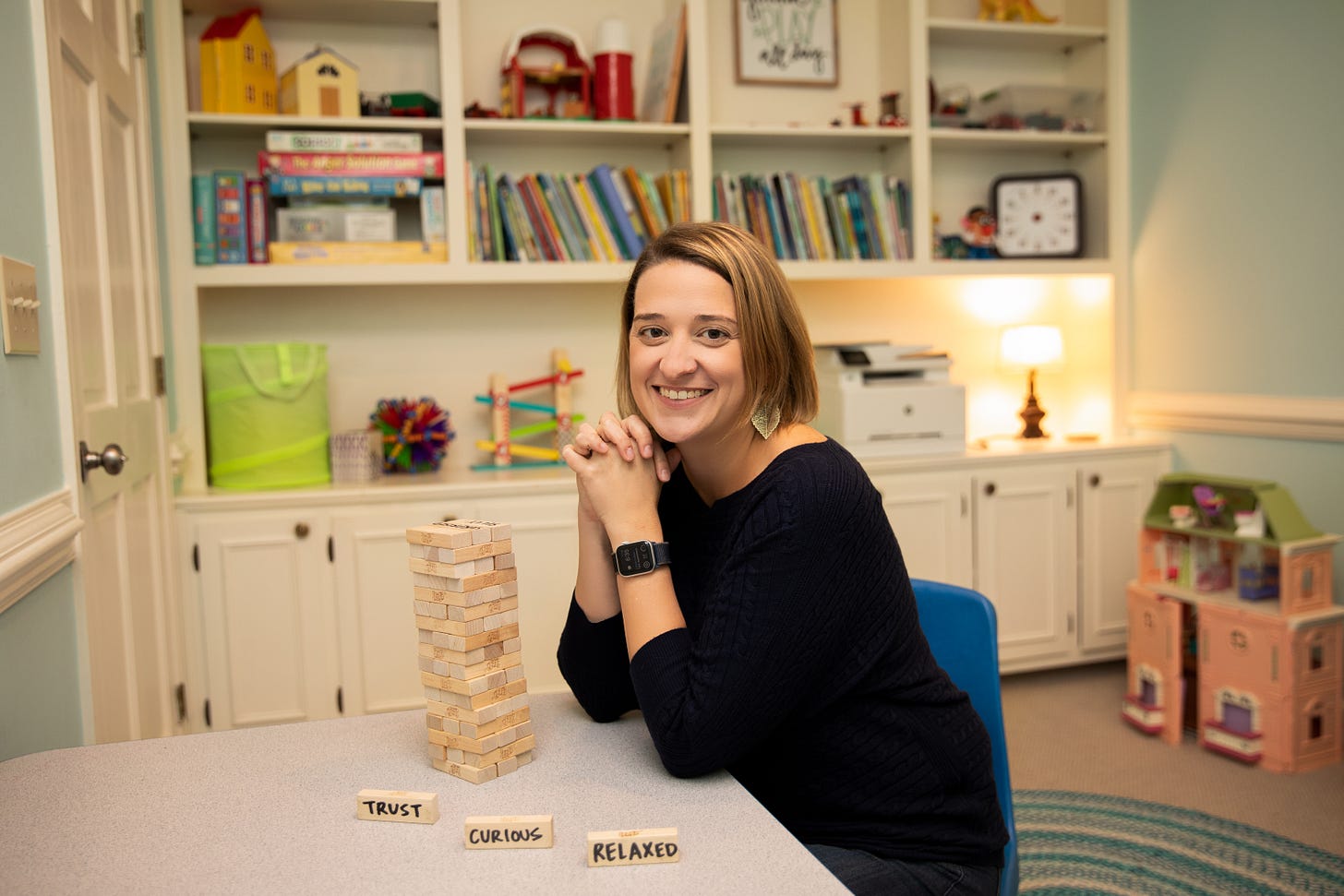
Simply put, children don’t do everything we ask them to do when we ask them to do it. As adults, we often assume this is because they are not understanding what we said so we try communicating the same expectation again by repeating ourselves, sometimes in a louder and more frustrated voice. If that doesn’t work, our own frustration grows, which can stop us from remaining emotionally regulated and problem-solve what to do next.
We are never our best selves when stressed. Yet, the way we respond in the moment a child doesn’t do what we have asked them to do can do one of two things: either it creates a safe connection for the child to trust us as we align with them to solve the problem or we trigger a defense response in the child if we inadvertently disregard their need for more support.
So, what does this look like in a classroom?
When Pre-K and Kindergarten students start the school year, no one expects them to know what to do. Teachers spend time building trust and safety, a sense of classroom community and routine, and then the learning can begin. As students get the hang of school, this settling into a classroom routine gets smoother each year.
However, many neurodivergent students continue to lack the skills needed to follow classroom routines later into elementary school. Just because a student is older doesn’t mean they have mastered the skills required to “be a student,” which usually involves emotional regulation, impulse control, executive functioning, and social problem-solving skills. It can be hard to remember that an older student may still need support to understand expectations, get started on their own, or negotiate differences with peers. And, this all happens before asking them to engage in any academic learning.
We have to remember that in order to complete a task a teacher has asked a student to do, the student must not only understand what is expected of them, but also needs to feel emotionally safe to begin a task they are unsure about (Remember: Learning is a vulnerable experience) plus they must have the skills to do the thing being asked of them.
When students don’t respond in an expected way, sometimes I hear teachers or school administrators say things like…
“He is choosing to put his head down and not get started.”
“She is choosing to argue with me instead of getting to work.”
“He is choosing to engage in unsafe behaviors.”
Let’s start by debunking the myth that reacting with verbal and physical aggression is a choice. Once children (and adults) are yelling, physically destroying things or are hurting others, they are most likely in a stress response trying to protect themselves from something they perceive as emotionally traumatic or too much for them. In other words, if a child is saying or doing things they would not do when they are calm, this is most likely a stress response, which I talk about in more detail in the blog post at this link.
Stress responses are not a choice. That would be like saying that I choose to run from the grizzly bear I saw in the woods or that I choose to grab my child’s arm when they stepped into the street in front of oncoming traffic. Choosing these responses would imply that I had the time to consider an alternative option and decided that this action was best. When we react to perceived danger, there is no time for a choice. Our brain immediately responds in the best way it knows how to feel safe.
Below, I take your through how to figure out if a child is having a stress response and how to support it. I want you to feel more capable in these moments!
Invest in yourself by becoming a paid subscriber! Or, become an all-access member to join monthly LIVE parent workshops. You, the kids, and your relationship are worth it.
Now, of course a child cannot be harmed by a math worksheet in the same way they would be by oncoming traffic, but it’s their perception of difficulty that is the “danger” here. If the task is too overwhelming due to high expectations and lack of skills, you may get a “non-compliant” response of freezing with a student’s head down on their desk. This is what the child knows how to do under these circumstances.
Sometimes I feel that when we say that a child is making a behavioral choice, we are insinuating that they have the ability to independently make a different choice. This is often not true for neurodivergent students. As Dr. Ross Greene says, “Kids do well if they can,” so if they can do better, they will do better. If they are making the choice to sit on the ground with their head in their hands when they were asked to line up and go inside from recess, the question we need to be asking ourselves is “Why?” What is upsetting them? What is overwhelming them? What is too much for them?
When a child is not doing what is asked of them, it’s time to get curious and start problem-solving. If a student with ADHD isn’t getting started when asked, it’s likely due to a lagging executive functioning skill. If an autistic student avoids a task or activity, more times than not it is due to a stress response of an overwhelmed sensory system and not a choice.
Neurodivergent students experience more lagging skills and are triggered more often and more easily than their neurotypical peers.
In some cases this is due to a sensitive nervous system and sometimes it’s due to previous school experiences. Many times it’s due to both. Remember, getting started on a task requires feeling safe in the environment, feeling connected to the person asking you to do the thing, plus the skills AND motivation to carry out the task. If one of these things is missing, a student’s ability to begin the task will likely crumble.
This crumbling will have different levels of severity depending on how the child responds to stress. I love this visual from Supportable Solutions™ which shows the three states of our nervous system depending on the perception of threat around us.
(Image via Supportable Solutions™)
When we feel safe and connected to either our people or our interests, we are able to learn. When we perceive a threat, some of us go into fight or flight and some go into freeze. This is a naturally-occurring, automatic response our brain has to defend us from danger. For many neurodivergent kids and adults, their nervous systems are more sensitive to these perceptions and many register a danger response that a neurotypical brain would not. Therefore, it’s important to believe a child when they communicate overwhelm, even if it doesn’t quite make sense to us.
When a child “chooses” non-compliance, there is always a reason; we just might not be able to see the reason. Some reasons are fatigue, hunger, constipation, and other overwhelm the child may not even be able communicate. As their trusted adults, we must collaborate to identify patterns and become detectives to help children feel safe and supported.
So, let’s get curious and figure out the following: Is the expectation too high? What skill is missing? How can I connect with this student to help them feel safe in this moment of learning? In other words, we can teach the child a safe, more productive way to respond when met with a challenge.
Imagine instead saying,
“He’s not getting started on his own. I wonder what feels overwhelming to him about this assignment?”
“She is getting upset and asking lots of questions about this assignment. I wonder what and how I could clarify this for her?”
“He is running and hiding under a table every time he’s asked to write. I wonder if he needs support with coming up with ideas, organizing his thoughts, fine motor skills, or all of the above?”
Problem-solving in these moments will take energy and practice from the adult in the room, but it will be worth it. That’s why I don’t teach these ideas without also discussing self-care for educators as well as parent-teacher collaboration. We have to keep showing up for our kids so they will learn to keep showing up for themselves when making mistakes during the learning process.
Let’s Stay Connected!
~Dr. Emily
P.S. In the comments, let’s share a time we felt like we were in a stress state and our behavioral response wasn’t a choice. These moments happen to adults, too!
I’m Dr. Emily, child psychologist and former school psychologist, and I’m on a mission to help parents and teachers be the best adults they can be for the neurodivergent kids and teens in our lives. This isn’t about changing the kids, it’s about changing us. Learn more with me at www.learnwithdremily.com.
**All content provided is protected under applicable copyright, patent, trademark, and other proprietary rights. All content is provided for informational and education purposes only. No content is intended to be a substitute for professional medical or psychological diagnosis, advice or treatment. Information provided does not create an agreement for service between Dr. Emily W. King and the recipient. Consult your physician regarding the applicability of any opinions or recommendations with respect to you or your child's symptoms or medical condition. Children or adults who show signs of dangerous behavior toward themselves and/or others, should be placed immediately under the care of a qualified professional.**




